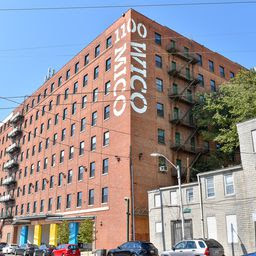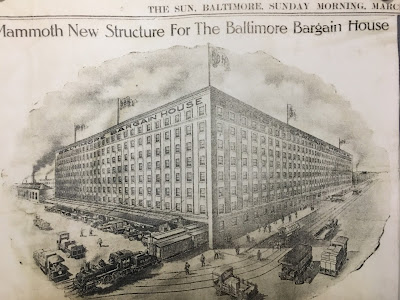 |
| The WICO front entrance area: dwarfing its neighbors (Photo: Brevitas) |
A co-working space where creatives, non-profits and start-up businesses work cheek to jowlIn 1915 distribution warehouses were called wholesale businesses. This one was an innovation for its size (416,000 sf), its large freight elevators, conveyor belts, and the logistics of how the wares were flowing through the building. This particular Amazon of the day was owned by the local immigrant Jacob Epstein, born in 1864 in Lithuania, who came as a 15 year old to Baltimore. Two years later, he already founded the Baltimore Bargain House, a business he incorporated in 1894. When even the Bargain House on Liberty Road (now the Nancy Grasmick Building) which Epstein had completed in 1911 wasn't large enough to hold all the goods he peddled, he commissioned on the eve of WW I in January 1914 an all new type of building that was bigger than any other in Maryland (it predates the Montgomery Ward building), a huge cavernous structure which current owner Chris Regan describes as "more of a hive". The Sun of January 11, 1914 notes that three steam engine run trains could be unloaded at the same time at a loading dock connected to the B&O tracks. Those tracks can still be seen leading into the building.
a place to conserve the heritage of sowing
a brewery and video arcade (in the works)
 |
| Baltimore SUN 1914, trains, trucks and merchandise (MD Jewish Museum) |
Epstein also built a local community of employees, which included over 1,600 people. The workforce was relatively diverse, comprising of immigrants from various countries as well as industry experts from across the nation. Many workers remained employed at the Baltimore Bargain House for decades.Mail order was already a thing back then, and Epstein issued annual catalogs featuring his goods that could be ordered and delivered, quite like today, except without a computer and, in his case, limited to wholesale. The Henry Ford Museum has some of his catalogs on display. It explains:
His catalogs featured a variety of clothing, personal accessories, fabrics and household goods available to shopkeepers and retailers.
 |
| Page 192 of Epstein's mail order catalog in 1915 (Henry Ford Museum) |
The Jewish Museum of Maryland describes Epstein in a biographical sketch as a figure of note in Baltimore, in a long list of other outstanding Baltimoreans:
Epstein was the Baltimore Jewish community's most prominent philanthropist in the first half of the twentieth century. He established the Mount Pleasant Home for Consumptives (the Jewish TB sanitarium) and played a major role in the Federated Jewish Charities and the United Hebrew Charities, the two organizations which would later merge to become the Associated Jewish Charities. He was the Associated's most important contributor in the 1920s and 1930s. He helped establish the Baltimore Museum of Art and sat on the Board of Directors; his personal art collection was one of the founding collections of the museum. He also raised funds for the establishment of the Johns Hopkins Homewood campus. Epstein also helped finance a Baltimore baseball team in 1913 for the short-lived Federal League.The once modern building eventually became a giant albatross. After its heyday under Epstein who died in 1945, Pigtown's largest building was largely forgotten. It idled in the hands of Baltimore City from 1976 until 2003, when it took its first run as an innovation center, then under the name of "the Raleigh". under the helm of a Boston firm and with the intent of creating a business telecommunications incubator and a trade center that would focus on bringing U.S. headquarters of Chinese businesses to Baltimore. (BBJ). The building changed hands for $1.25 million. In 2007 the building changed hands again for now $8.8 million and was finally sold again in 2017 for $10.9 million, this time to the current owner Tower Hill LLC. The building is now assessed for 10.38 million.
Epstein was a major civic leader. He served on the Public Improvements Commission, the supervisory body charged with developing the land that Baltimore City annexed from the County in 1918, which tripled the size of the city. He also worked to make Baltimore the major supplier of goods to the South.
 |
| Sew Bromo: Tradition and progress in the garment industry (Photo: Stacey Stube withNicole Samodurov and Susan Clayton Sew Bromo) |
The spirit of the current 1100 Wicomico is Chris Regan, a Brown University graduate who wanted to be an architect but wound up graduating as a behavioral science major working in financing and affordable housing. In 2001 he created his own real estate and consulting firm Tower Hill which now operates out of the Wicomico, which is the company's flagship revitalization project. Regan discovered that "the WICO" has deep historical roots and made sure the building was redesignated as contributing in the Pigtown historic CHAP district, although he didn't success to get funds from the forever underfunded State historic tax credit program. It irked him that the vacant and burnt out Ice House team received $3 million and had to return the money for non action while his employment hub went empty.
Some of today's occupants dream big just as Epstein once did. And not all is about new technology. For example, Stacey Stube: Born around the corner to an immigrant she moved her "Sew Bromo" enterprise into the building, a step that was featured in the Baltimore Business Journal. She operates under the brand name Elsa Fitzgerald.
[Stube] is plotting a pilot to bring entrepreneurs and industry experts together to help grow a new generation of fashion businesses.
The SEW BROMO - Fashion Innovation Hub will support startups by providing education and small-batch production support. Stube hopes the space can serve as a small factory operation, where local and global fashion entrepreneurs can learn about garment manufacturing from the digital space.
The hub will provide fashion entrepreneurs with ample space, tools and support as they navigate everything from learning traditional garment-making skills, to crowdfunding to support production, to online marketing and sales.
A year in, Stube didn't quite make her goal of raising $100,000 through a much recognized 8 day 200 mile super-marathon run, but her aspiration to save the history and art of sewing for Baltimore is no less ambitious and her enterprise appears to be flourishing thanks to her tenacity.
 |
| Stacey Stube at 1100 Wicomico's garment factory Innovation at Fashions Unlimited (Photo:Jill Silverman) |
Another tenant with high aspirations is Early Charm Ventures. In their own words, they are "a venture studio, founded in 2012 in Baltimore, that converts science to business." The company specializes in taking scientific discoveries made at universities and turning them into start-up companies. They offer their experience in linking companies with researchers. Lifting Labels is "guided by [the] mission to reduce poverty [and] is "Changing Lives with Each Stitch" to ensure that formerly incarcerated men and women can find and retain quality, empowering jobs when they return home to Baltimore City by manufacturing ceremonial apparel." Cindy J. Cosmetic Labs is a woman owned minority business "with her own formulation laboratory for Cosmetic business owners who want to start their own line of products like Hair Care, Skin Care, Color Cosmetics, Men’s Care, Baby Care, and Bath & Body Care." Galen Robotics "is developing a single-platform solution to aid surgeons across several disciplines with minimal disturbance to existing workflows. Our cooperative control paradigm aims to eliminate hand tremor and enable surgeons to realize precise minimally invasive interventions in otolaryngology, spine surgery, and tissue reconstruction that were previously considered beyond human capacity".
The building has plenty of space left, even after a new brewery will open on the first floor, potentially with pop up spaces in the fall and a final opening next spring. Vagrant Coffee already operates a small coffee shop on the first floor. The eight floor, wide open and offering fantastic views across Baltimore on all sides remains up for grabs. Representative of the dynamic image the project emanates, things are in constant flux. The City of Baltimore operated a contact tracing operation here that came and went. Morgan University held events here and had an exhibit about redlining. Politicians hold fundraisers, a food truck sets up and then disappears. Hammering, boring and cutting are frequent noises, telegraphing well through the heavy concrete structure.
 |
| Events on the 8th floor: MSU lecture in 2019. (Photo: Philipsen) |
I should mention that I rented a small co-working place in the building after my lease on 429 N. Eutaw Street ran out and I was looking at a much smaller space in a creative setting. My neighbors in the co-working suite are sevenwcllc, an interior designer and the marketing startup Goldiata Creative as well as developer Dean Harrison. The current directory lists 52 tenants. COVID has slowed activity in the hub, but certainly not squashed it.
The Wicomico is the spark for other entrepreneurial in the area of the adjacent Carroll Camden industrial park. Next door a 116,000sf industrial building will be converted by Mayorga,Organics LLC, an organic coffee company that also enables sustainable coffee farming in Latin America, relocating from Rockville to Baltimore. Several other long dormant buildings in Carroll Camden Industrial Park are also slated to become active again. Also in a perpetual state of renewal but with a clear upward trend: Pigtown’s “Main Street”, Washington Boulevard with its newly dedicated pig weathervane gateway symbol designed and fabricated by local resident and sculptor Rodney Carroll.
In the trajectory from innovative hub of economic vitality to decades of decay and dormancy to failed attempts of revival all the way to a renaissance that consist of part future, part past, part entertainment and part food seems to stick. In that the Bargain House/Raleigh/1100 Wicomico represents a mirror to what happened and continues to happen to the entire city.
Klaus Philipsen, FAIA
No comments:
Post a Comment